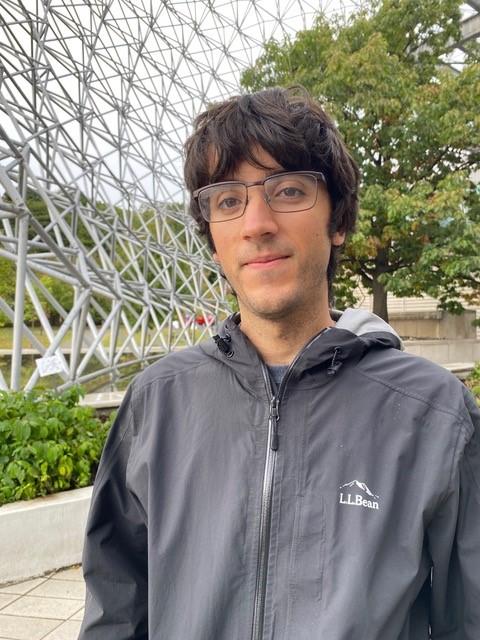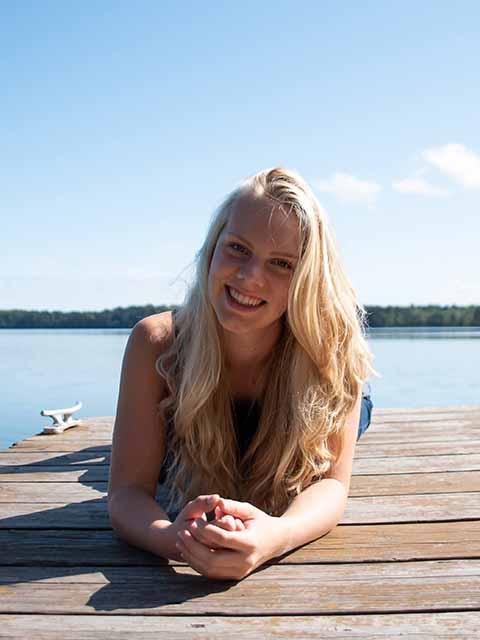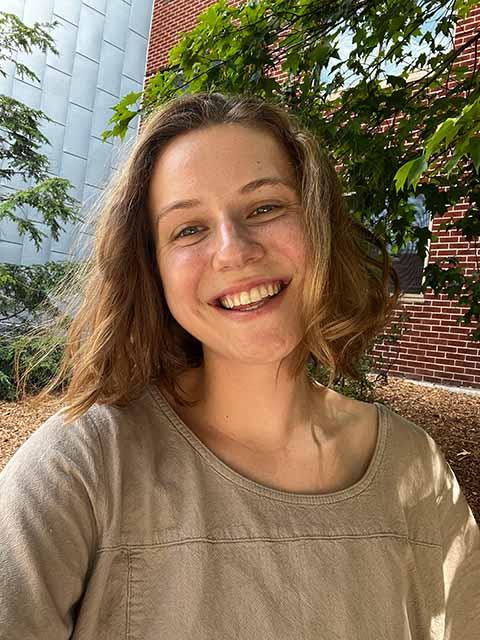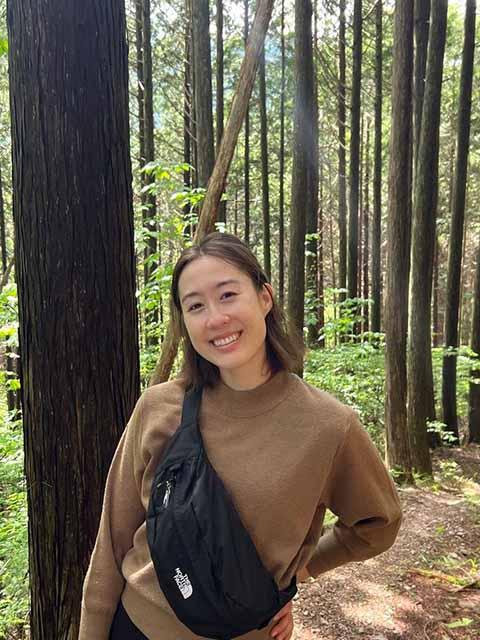
Isabella Adamo
University: Virginia Polytechnic Institute and State University
Major: B.S. Environmental Science (Ecological Restoration)
Faculty Mentor: Arthur Kneeland
"Potamogeton crispus Interrelationships with Ecosystem Metabolism: An Aquatic Plant Survey of Lake Menomin"
Isabella, a current senior at Virginia Tech, is pursuing a degree in Environmental Science with a focus on Ecological Restoration. Her interest in the field started in high school when she enrolled in a four-year agricultural program. This program served as a strong foundation in many components of environmental science, prompting her to delve deeper into the subject matter and eventually choose it as her major at Virginia Tech. As an executive member of Virginia Tech’s conservation service fraternity, Lambda Iota Mu, she is passionate about educating the public about local ecosystems. Her service work closely aligns with her major interests, as she primarily focuses on invasive species removal. This summer, she advanced her work with invasive species; specifically, Potamogeton crispus abundance and its effect on community and ecological processes. Through her research, Isabella aimed to contribute valuable insights into invasive macrophyte populations and behavior in Lake Menomin. After graduation, she plans to attend graduate school and continue her research in ecology.
Potamogeton crispus Interrelationships with Ecosystem Metabolism: An Aquatic Plant Survey of Lake Menomin
- Poster: Adamo_Isabella_LAKES2023.pdf
Preserving the quality of Lake Menomin is a shared concern that unites every resident.
When we think about the causes of the blue-green water Lake Menomin is known for, the first that come to mind are farm runoff, septic tanks, or lawn fertilizers. But what if there was a contributing factor already present in the lake? Potamogeton crispus, an invasive species known as curly leaf pondweed, has been a restricted species in Wisconsin since 2009 due to its ability to survive and thrive in a variety of conditions. This invader can outcompete native species and form dense mats that eventually store and then deposit phosphorus as they deteriorate with age. This leads to excessive nutrient loads in a body of water which can, in turn, create dead zones or harmful algal blooms. Is it possible that the invader P. crispus has an additional effect on the already EPA-designated impaired Lake Menonomin?
A Survey of Lake Menomin
We conducted a plant and water survey to estimate the amount and number of different species throughout Lake Menomin. From the plant samples we collected, we were able to identify ecosystem composition and how prevalent P. crispus was. Ultimately, P. crispus made up only 15% of the plants collected from sample sites, with sites having an unexpected diversity of native plants. In short, while P. crispus may be an effective invader across Wisconsin, native plants are still be able to compete at a small scale within Lake Menomin.
We also measured disolved oxygen, temperature, and light levels at multiple locations. This data allows us to assess the amount of photosynthesis and respiration happening at each site, which is referred to as “gross primary productivity” or GPP. While we did find a moderate correlation between GPP and total biomass, we did not find a relationship between the presence of P. crispus and GPP. This indicates that while P. crispus is present in Lake Menomin, it was not seen to be an aggressive invader at the recorded sites. This data further supports the idea that native species are likely able to compete with this invader, even in nutrient rich environments. However, because we were only able to sample a limited number of sites, it is possible that P. crispus is dominant in other locations. Thus a large-scale plant survey for the lake is still needed as this is vital to understaning how the lake has responded to increasingly nutrient-rich conditions and how it will evolve over time.
While confronting the challenges of eutrophication and invasive species, our newfound knowledge of native biodiversity equips us with hope to move forward. Through continued research, our shared concern for Lake Menomin empowers us to understand the developing intricacies of the disturbed ecosystem. With each summer research cohort, we gain new perspectives on preserving the health and vibrancy of this water body.

Ayers Aguiar
University: University of Maine at Farmington
Major: Earth and Environmental Sciences (Environmental Science)
Faculty Mentor: Nicole Hayes
"Trends in Anatoxin-a and Microcystin Concentrations in Two Eutrophic Lakes: The Role of Habitat and Season"
Interested in exploring topics at the interstices of human and ecosystem health, I am an Environmental Science student from the University of Maine at Farmington. Originally from Cedar Rapids, Iowa, I feel at home amidst the friendly Midwestern culture of Wisconsin. My interests include reading, listening to music, and hiking. When I am not studying for class, I am often eagerly, perhaps overeagerly, hiking the blue mountains of western Maine.
Trends in Anatoxin-a and Microcystin Concentrations in Two Eutrophic Lakes: The Role of Habitat and Season
- Poster: Aguiar_Ayers_LAKES2023.pdf
As an undergraduate student participating in the LAKES REU, an interdisciplinary research experience for undergraduates funded by the National Science Foundation (NSF), I got to develop my own research question and work on addressing it over the course of the summer. As an interdisciplinary group, the LAKES team bridges sustainability, psychology, political science, and environmental science to better understand degradation of lake waters and brainstorm solutions to this challenging problem. Lake Menomin, a part of the Red Cedar Watershed that gives the town of Menominee, Wisconsin, its beautiful lakefront, is a great example of how the degradation of lakes impacts the entire community. The lake, covered in ice and adorned with ice fisherman during the cold months of the winter, turns brilliantly green during the summer months, often dissuading recreators and sometimes emitting an odor that can be smelled throughout Menomonie.
An overabundance of blue-green cyanobacteria during the summer months is mostly what you see when faced with this dramatic seasonal color change on Menomonie’s waterfront. For context, cyanobacteria are single-celled organisms that use sunlight to carry out photosynthesis. Cyanobacteria can produce chemicals that are dangerous to humans, including microcystin and anatoxin. Microcystin can cause liver failure at high concentrations, while other impacts continue to be researched. Anatoxin can cause neurological and gastrointestinal symptoms at high concentrations. One difference between the two toxins is that, for microcystin, symptoms typically occur over an extended period. For anatoxin, however, symptoms could be present within minutes of exposure. The presence of cyanobacteria in the water does not necessarily indicate that the water is toxic. The Environmental Protection Agency (EPA) has set limits for microcystin in drinking water and similar recommendations for anatoxin have been made by the World Health Organization (WHO).
With the assistance of my mentor, Nicole Hayes, and the rest of the LAKES team, I eventually decided that I wanted to know more about how lake habitat influences the presence of microcystin and anatoxin. I hypothesized that cyanobacteria that live towards the bottom of the lake which produce anatoxin would be more abundant earlier in the season. I also predicted that cyanobacteria that produce microcystin would be more abundant near the surface of the lake and later in the season. In June and July I went out on the boat to collect data near the lake surface and near lake sediment for Lake Menomin and Lake Tainter. At each site I collected water that we would take back to the lab to determine the amount of cyanobacteria and toxins. All of this was done with lots of help from other students and my faculty mentor.
After the data was analyzed, I found that microcystin levels were above safe drinking water levels at nearly all of the sampling sites in July. However, none of the sites were above recommended microcystin or anatoxin levels in June. Anatoxin was found less frequently in Lake Menomin and Lake Tainter but was detected at several sites near the lake's surface and towards the bottom. One site in Lake Menomin had concerning levels of anatoxin above the limit of detection. Overall, we saw an increase in cyanobacteria at the lake surface later in the summer and higher microcystin levels. I did not find evidence for my hypothesis that anatoxin would be present more in the spring and near the bottom of the lake.
The detection of high levels of microcystin and anatoxin should encourage further monitoring of toxins in the lake. Caution should be exercised when interacting with these lakes. Although the EPA recreational microcystin limit is higher than levels detected during sampling, there is potential for microcystin levels to be above EPA recreational limits. The relationship between habitat and toxin levels in both west-central Wisconsin lakes was not as simple as was predicted at the beginning of the study. Further research on lake habitat and cyanobacteria community is needed to better understand and predict toxin presence.

Eva Bruce
University: Smith College
Major: Anthropology; Government
Faculty Mentor: Kim Zagorski
"Partisan Influence on Perceptions of Drinking Water Quality and Policy in Dunn and Barron Counties"
Eva is a junior at Smith College, where she studies Government and Anthropology. Growing up in Montana, she was first exposed to environmental policy through the intersection between agriculture and resource conservation. Eva hopes to combine environmental anthropology and political science to explore how rural communities shape and respond to their surrounding environments, especially in areas with intensive natural resource uses, such as mining or agriculture. She eventually plans to go to graduate school to further her studies in these fields. Outside of research, Eva likes to read, hike, and is on her college’s debate team, where she spends too much time talking about finance and not enough time talking about the environment.
Partisan Influence on Perceptions of Drinking Water Quality and Policy in Dunn and Barron Counties
Link to poster: Bruce_Eva_LAKES2023.pdf
In the Flathead Valley of Montana, where I grew up, one of the most polarizing issues within the community was the proposal of a water-bottling plant on Flathead Lake. While everyone cared about the lake’s water quality, they had different ideas of the best way to balance competing business and environmental interests. Coming to Menomonie, I was interested to see how polarization on water played out against an incredibly different backdrop. While our concerns in Montana were centered on keeping the lake clean, I wanted to see how pre-existing water issues could shape public perception of water and water policy.
To do this, I focused on drinking water. Drinking water sits at the intersection of environmental and public health policies, both of which have become increasingly polarized. Polarization in areas like climate change can easily trickle down into associated issues, such as drinking water. However, because drinking water is vital for survival, it may avoid the partisan pitfalls that impact other environmental issues. As a result, I asked a few key questions during my time here: Does political identity change how people perceive drinking water quality? Does political identity impact the kinds of policies that people support? Are partisan divides present within the branches of local government that are making water policy?
I knew these questions couldn’t be answered easily, so I used a mixed-methods approach to address as many perspectives as possible. I interviewed eleven Dunn County residents, including government officials who worked on drinking water, to understand the hurdles to clean drinking water and the impact of partisanship on policy decisions. One theme emerged from both government officials and community members: everyone agrees that drinking water is important, but we can’t agree on how to go about it. Despite this, residents said they trusted the local government to do the right thing regarding drinking water. From these interviews, I concluded that while partisanship in government may exist to some extent, drinking water hasn’t polarized so much that it prevents effective policy.
However, I still needed to figure out how partisanship worked in community members more broadly. To do so, I sent out 1,500 surveys to Dunn and Barron County. These surveys asked residents how concerned they were about their own drinking water, as well as how important they thought a range of water issues were. I was also curious about how people responded to policy, so I asked about how much people supported different regulations and policies that impacted drinking water.
Once I analyzed these survey results, I realized that they supported my findings from my interviews. Political identity really didn’t impact how concerned people were about drinking water. However, this wasn’t the case for the policy side of things. As respondents became more right-leaning, they also became less likely to support regulations and policies geared toward addressing water quality. Although a divide in policy may exist, it’s certainly not insurmountable; in general, more bipartisan support existed for policies that required low government intervention, such as expanding eligibility for grants to replace nitrate-contaminated wells.
Despite having a lot of common ground on drinking water across political identification, respondents perceived high levels of partisanship. When asked how much confidence they had in community members of the opposite party to “do the right thing” regarding drinking water quality, nearly half of respondents said that they had little or no confidence. However, people do trust local government, with less than a quarter saying that they had little or no trust in local government. These results indicate three things. First, there is little to no polarization on how important people think drinking water is. Second, there is some polarization on how people want to solve drinking water problems. Third, people perceive substantial community polarization on drinking water issues, but this doesn’t necessarily extend to local government.
While polarization is never good news, these results indicate that community-wide, bipartisan collaboration on drinking water issues is possible. For the most part, people have the same goal of making sure that community residents have access to clean, safe water. While we may have different ideas about the best way to get there, there is a desire for local government to work across partisan divides on this topic. Local government can mitigate the impact of partisanship on water quality by emphasizing common ground and interests across political identifications. Back home, the shared interest of clean water was eventually enough to win a lawsuit that shut down the water bottling plant. It’s my hope that with this common goal in mind, Menomonie can achieve the same clean water without legal battles or community rifts.
The detection of high levels of microcystin and anatoxin should encourage further monitoring of toxins in the lake. Caution should be exercised when interacting with these lakes. Although the EPA recreational microcystin limit is higher than levels detected during sampling, there is potential for microcystin levels to be above EPA recreational limits. The relationship between habitat and toxin levels in both west-central Wisconsin lakes was not as simple as was predicted at the beginning of the study. Further research on lake habitat and cyanobacteria community is needed to better understand and predict toxin presence.

Genevieve Czaplewski
University: University of Wisconsin-Stout
Major: Applied Social Science
Faculty Mentor: Kim Zagorski
"The Influence of Trust in Science and Political Leaning on Perceptions of Drinking Water Quality"
Genevieve is from Grand Island, Nebraska, and will graduate from UW-Stout in 2024 as an Applied Social Science major. The LAKES REU Program spoke to her specifically due to her familiarity and closeness with farming and water quality, as her home state is known for its corn, cattle, and the largest aquifer in the United States. Additionally, living within the Red Cedar Watershed for three years has placed the region close to her heart, and being able to research and understand the community behind it made her even more connected with it. Genevieve’s passion and background in political science led her to focus specifically on how public trust in scientific institutions influences perceptions of drinking water quality and how those perceptions are influenced by political leaning. She has thoroughly enjoyed getting to know and bond with the other researchers and mentors as well as the many fun excursions they have attended, including canoeing the Red Cedar River, visiting a farm dedicated to sustainable practices, and having bonfires and cookouts. Genevieve also proudly represents the UW-Stout gymnastics team and loves showcasing the academics that go on outside of the sport. After she graduates in the spring, she plans to continue her education by attending law school and obtaining her J.D. Her hobbies include video games, shopping, embroidery, gardening, and visiting local coffee shops.
The Influence of Trust in Science and Political Leaning on Perceptions of Drinking Water Quality
This summer, I researched how trust in scientific institutions and political beliefs influence perceptions of drinking water. Past research shows that drinking water quality is becoming a national issue and is widely regarded as an important environmental problem. As with many other environmental issues, including climate change and land conservation, it has the potential to become widely politicized. Furthermore, individual trust in science is influenced by a variety of factors, including gender, education, and religious affiliation. The COVID-19 Pandemic also acted as a catalyst to rapidly widen political gaps regarding science. The way individuals think about science plays into their concern about environmental issues. This idea of scientific trust had not yet been applied to the issue of drinking water quality. My research helps to fill this gap, and I hoped to find that something as simple and universally needed as drinking water would not become a political issue.
This study relied on both a mail survey and interviews. 1500 surveys were sent to a random sample of Dunn and Barron County residents who were asked about concern with drinking water, which institution they trusted most to give them accurate scientific information, their political beliefs, and other demographic questions. The survey was also distributed at the Menomonie Farmer’s Market. A little over 200 responses were collected. Interview participants were both Menomonie citizens and local water quality enforcement officials, and the interview questions covered similar topics but looked to get a more personal view on how this issue impacted everyday life and work. Citizen participants were put in contact with me through a LAKES REU mentor, and enforcement participants were emailed directly and asked to participate.
Thankfully, the results showed that partisanship has not yet affected concern regarding drinking water in Dunn and Barron Counties. This is hopeful considering how political other environmental concerns have become. There was, however, variation in which institutions would be trusted most to give accurate scientific information regarding drinking water quality, and this variation did fall along ideological lines. Right-leaning individuals were more likely to trust friends and family and state government, while those who leaned to the left were more likely to trust university scientists and the EPA. Those who identify as moderate were spread quite evenly along all institutions. Additionally, local government and Dunn County Public Health were both universally trusted. Further research should examine how scientific trust relates to concern with other environmental issues, like global warming and land conservation, to assist scientists in effectively presenting information to the public.
Growing up in Nebraska in a town situated directly over the largest aquifer in North America, ground and drinking water are close to my heart. Additionally, the polarization of science that came with the COVID-19 Pandemic was fascinating to watch as a political science student. This research combines these interests and is applicable to the communities along the Red Cedar Watershed which I have grown to love during my three years at UW-Stout. Getting to work with individuals from across the country was an amazing opportunity, and this program has taught me skills that I will undoubtedly carry with me through the rest of my academic and vocational career.

Sarah Gawlik
University: University of Houston
Major: Psychology
Faculty Mentor: Sarah Wood
"Role of Source Credibility on Persuasion Towards Conservation Farming"
Sarah is from Dearborn, Michigan and will be a senior at the University of Houston in the fall of 2023. She is a psychology major in the Honors College minoring in classical studies and medicine & society. After graduating, she hopes to attend graduate school to earn a PhD in social psychology. She plans to pursue a career in research focusing on motivation and persuasion within the domain of environmental behaviors. Growing up around the Great Lakes and in the Rouge River Watershed has instilled an appreciation of natural and ecological resources within her. The LAKES REU has provided her the opportunity to combine her love of social psychology with her passion for environmentalism. In her spare time, Sarah enjoys reading, baking, and wrangling her rambunctious dogs.
Role of Source Credibility on Persuasion Towards Conservation Farming
- Poster: Gawlik_Sarah_LAKES2023.pdf
As much as we like to think that we only rely on the cold, hard facts when making decisions, the truth is that several other outside factors influence our decision. These can include the flashy graphics of an eye-catching advertisement, the mood we are in that day, or even who is communicating the message. This last point is what I was most interested in researching this summer. My project revolved around how source credibility may impact persuasive arguments about adopting conservation farming practices.
Because a lot of land in this region is dedicated to agriculture, it is important to consider how land management practices may impact the surrounding environment. For instance, conservation farming practices like cover crops and grass waterways promote soil integrity, decreasing the runoff of pollutants into the local watershed. Encouraging the adoption of these conservation farming practices can be challenging since many factors influence how persuasive a message is. Focusing on source credibility, I wanted to determine who local farmers find most credible in order to understand how to communicate information about conservation farming practices in the best way possible.
I created a survey containing questions about a variety of groups that may approach farmers about implementing conservation farming practices. These groups included: neighbors/other farmers, farmer-led councils, local conservation groups, county conservation services, state level regulatory agencies, and federal regulatory agencies. The survey asked participants to rate these groups based on familiarity, knowledge about farming practices, trustworthiness, and persuasiveness. I mailed this survey to a random sample of 300 farmers in Dunn and Barron County. A QR code to an identical digital version of the survey was also passed out at the Menomonie farmer’s market.
Data from the twenty-nine surveys that were returned showed that there was a clear divide among the groups. Groups that were more local were rated higher than more distant groups like state and federal regulatory agencies. Of the local groups, neighbors and county conservation services were rated as the most trustworthy and knowledgeable. Additionally, respondents who rated farmer-led councils as trustworthy and knowledgeable tended to report using more conservational farming practices. This may suggest that farmer-led councils are also an important and influential group.
Having this information allows us to better understand how to engage in open communication about conservation farming practices that will benefit everyone in the community. When approaching individuals about adopting conservation farming practices, it is important to emphasize ties to the local community. Additionally, county conservation services, farmer-led councils, and peer farmers should be integral to leading these conservations. Hopefully, this data will lead to open and fruitful conversations that will promote healthier soil and in turn a healthier Red Cedar Watershed.

Anja Huesby
University: University of Wisconsin-Stout
Major: Psychology
Faculty Mentor: Sarah Wood
"Consumer Attitudes & Preferences Toward Sustainability vs. Shopping Behaviors"
Anja is from Gordon, Wisconsin and is a senior at the University of Wisconsin-Stout majoring in psychology with a self-designed concentration in community health and minoring in cultural anthropology. Her free time is spent reading books, caring for houseplants, spending time with friends and family, and going on outdoor adventures. She found being part of the LAKES program to be one of the most rewarding and educational experiences of her life and is excited to use the lessons and skills she gained from it in her future career. After graduating college, she plans to earn a Master's degree in Clinical Mental Health Counseling and become certified in ketogenic and metabolic therapy for those with mental illness.
Consumer Attitudes & Preferences Toward Sustainability vs. Shopping Behaviors
- Poster: Huesby_Anja_LAKES2023.pdf
Because most of the land in our area is dedicated to agriculture, there is a lot of pressure on farmers to adopt better land management practices that minimize nutrient runoff that flows into the Red Cedar watershed. However, incorporating sustainable farming methods is easier said than done. Many farmers, including the owner of the farm we visited at the beginning of our research, believe that sustainability is important but challenging to implement due to the lack of support from consumers. On the flip side, there is also increasing pressure on consumers to help fix environmental issues by behaving more sustainably. Yet, as all consumers know, sometimes making sustainable purchases is not always easy or even an option.
This pattern of individualizing responsibility to one group or the other inspired me to focus my research on consumer attitudes toward sustainability and people’s shopping behaviors. My hope for this project is to encourage sustainable behaviors in both groups by giving farmers a better understanding of what consumers consider important when buying food so they can market their farming products and methods in a way that aligns with consumer preferences.
I started by looking at previous research on consumer behaviors and learning about factors that increase sustainability. With the help of Dr. Sarah Wood of the University of Wisconsin-Stout, I created a community survey with a series of questions dedicated to understanding: 1) people’s awareness about the environmental impact of consumer behaviors and farming practices, 2) people’s preferences and purchasing tendencies for sustainably and locally sourced foods, 3) people’s level of connection to their communities, local farmers, and the environment, and 4) people’s sense of responsibility to contribute to reducing water pollution and behave more sustainably. 1,500 surveys were evenly distributed to Dunn and Barron County. 146 of them were completed and returned, but after eliminating 14 that were only partially completed, I was left with a final sample size of 132.
I found that those with higher levels of awareness have stronger preferences toward sustainability and that those with higher levels of connection have a greater sense of responsibility. Most respondents agree that sustainability is important and that it is their responsibility to support local farmers. However, as consistent with previous research, there is a disconnect between consumers’ supposed preference toward sustainability and their shopping behaviors.
When asked to rank what matters most when buying food, respondents overwhelmingly ranked sustainability as least important. Furthermore, hardly anyone buys the majority of their food from local co-ops or directly from farmers regardless of the season. While it is unsurprising that most people buy most of their food from large-chain grocery stores, I was hoping that more people would report buying from local stores or farmers at least during the summer. This implies that consumers may not associate sustainable behaviors with buying food directly from farmers which could explain why farmers do not feel supported.
These findings are important to consider when encouraging both farmers and consumers to be more sustainable. Consumers clearly believe that sustainability is important and want to engage in more sustainable behaviors. The more consumers are aware, the more they prefer sustainability, and the more they feel connected, the more they feel responsible to be sustainable. I suggest that farmers invite community members to visit their farms to increase consumer awareness and connection. By doing so, it would provide people a chance to act on their preference to be more sustainable and increase support for local farmers. I also suggest that connecting factors that consumers consider important when buying food to sustainable farming practices would also be a good strategy to increase support. For example, farmers could explain that quality (ranked as most important to consumers) is not only the aesthetics of food but also includes things like soil health, environmental protection, and improving water quality. I hope that understanding consumer preferences toward sustainability can help farmers receive more support.
This research program has been full of amazing new experiences and learning opportunities that have deepened my understanding and appreciation for the environment and the importance of community. The main thing I learned is that we are all contributing to water pollution, but more importantly, we also all have a part to play in creating a solution. Individual actions are not enough to improve water quality, but the collective effort of our community if farmers and consumers worked together can result in meaningful and lasting change.

Grace Parrott
University: Luther College
Major: Environmental Science
Faculty Mentor: Nicole Hayes
"Horizontal and Vertical Spatial Symptoms of Cyanobacteria Blooms"
Grace is from Iowa City and is a senior at Luther College in Decorah, Iowa. She is pursuing a degree in environmental science and biology. Growing up in Iowa, a state where over 85% of the land is in agriculture, she is familiar with the water quality challenges for wildlife, recreation, and drinking water. Through her studies, she has become interested in more deeply understanding these issues and wants to bring her experience to conservation work at the local or state level. When not doing science, Grace enjoys running, playing jazz trumpet, hanging with a kitty, and spending time with friends.
Horizontal and Vertical Spatial Symptoms of Cyanobacteria Blooms
- Poster: Parrott_Grace_LAKES2023.pdf
Every summer in early July Lake Menomin turns a lovely shade of green. Waves wash up the boat launches and color the cement. Residents who live nearby experience sewer-type smells and are forced to close their windows. Can I eat fish from the lake? Is it safe to swim or water ski? These situations and questions plague residents of Menomonie and many others who live near a compromised water body.
The well-known green scum that floats at the water's surface is due to the overgrowth of cyanobacteria, commonly known as blue-green algae. Cyanobacteria is present in all lakes but can proliferate and form “cyanobacterial harmful algal blooms” (cHABs) under high nutrient conditions. The nutrients cyanobacteria need to thrive – nitrogen and phosphorus - naturally occur in the environment, but their use in farming, mainly in fertilizers designed to increase crop yields, and their subsequent runoff from the soil during rain events has introduced more nutrients than normal into lakes and streams. Other sources, like household lawn fertilizers, vehicles, and wastewater, are contributors, but because the primary land use in this area happens to be agriculture, field runoff is the source of most of the nutrient load in lakes and streams.
Not only are these blooms visually unappealing, but they are also an environmental and health hazard. The overproduction of cyanobacteria shade out native plant species and use up oxygen fish need to survive, leading to die-offs. Additionally, cyanobacteria produce a variety of toxins – liver, brain, cell, skin - that are a threat to wildlife, dogs, and cause skin irritation and gastrointestinal discomfort in humans. This has implications for recreation, boaters, and fishers. The local economy takes a hit as a result of this with less tourism and decreasing value of lake-front properties.
Because of these growing health concerns, I spent my summer studying where cyanobacteria and microcystin, a liver toxin, is most concentrated in Lake Menomin. To do this I sampled twenty-six points throughout the lake two times in July. I collected data at each site, such as the total phytoplankton biomass (both algae and cyanobacteria) and cyanobacteria specific biomass by measuring the pigments chlorophyll and phycocyanin respectively. I also collected a water sample at each site to measure the microcystin concentration.
The toxin microcystin is present in Lake Menomin. Microcystin concentrations varied across the lake and tended to be highest in the bays, where warm, stagnant, and shallow water is common, and cyanobacteria thrive. This, unfortunately, is where beaches are located. Although the bays of the lake showed the highest microcystin levels, the middle of the lake also reported high levels leaving boaters, fishers, and skiers at risk as well. Microcystin concentrations throughout the lake generally increased throughout July, exceeding EPA drinking water limits but staying below recreational limits. It’s possible the EPA recreational limit would be exceeded by the peak of cyanobacteria growth in mid to late August, but samples have yet to be taken to analyze this.
Bays had high microcystin levels not only because of their water characteristics, but also because they caught wind-blown cHABs. Because cHAB blooms occur on the surface of the water, they can be pushed around the lake by water currents influenced by strong sustained winds. Both days I sampled the dominant wind was northwestern and cHABs were blown into the eastern bay of Lake Menomin concentrating the microcystin toxin in this area. Environmental factors are important in determining which areas of the lake are safest to recreate in.
Determining the key signs of cHAB formation is also important because the risk can be assessed before it is present, allowing public officials and the public to prepare. Looking at community dynamics of chlorophyll and phycocyanin is a good indicator of bloom formation. As the summer progresses, the surface phytoplankton community, consisting of both algae and cyanobacteria, shifts to greater concentrations of cyanobacteria indicating increased bloom formation. Looking at the communities at depth and the surface can show when cHABs are developing and starting to cause greater water quality concerns.
So, what do we do with these findings? My hope is that this project will help the public and community know the real health risks of cHABs, incentivizing the public and decision-makers to improve nutrient pollution in Lake Menomin. These maps are an effective visual to understand the danger of one of the toxins produced by cyanobacteria. This allows the public to have a better grasp on the risks of recreation and public officials to understand nutrient pollution as a public health issue. There are currently many county conservationists, department of natural resource officers (DNR), and federal officials currently working to reduce nutrient pollution by preventing soil loss on agricultural fields. Their work has been valuable in not only improving water quality but also farmer costs. My hope is that my work will give further meaning and importance to the work currently being done.

Josh Rosenstein
University: Middelbury College
Major: Environmental Economics
Faculty Mentor: Arthur Kneeland
"Win-Win Opportunities: How Diversifying Farm Operations Can Lead to On-Farm Environmental and Economic Gain"
A rising senior at Middlebury College, Josh is an environmental science major with a focus in economics, as well as a psychology minor. Josh is an avid outdoors enthusiast, and will happily spend all day outside hiking, swimming, or any number of other outdoor activities with friends and family. Growing up in Massachusetts and attending college in Vermont, Josh has been treated with beautiful scenery and opportunities for outdoor adventures, which inspires both his appreciation for nature and his passion to preserve and protect it. Josh also loves sports as both a fan and a player, as he is on the Middlebury Club Soccer team and plays basketball and golf when he can, though there is plenty of room for improvement in his golf game. Among his other activities at Middlebury, Josh writes for the sports section of the school newspaper, mentors high school students through the college application process, and participates in a sustainable investment club. He was thrilled to spend the summer in Menomonie researching and learning more about agriculture in the area.
Win-Win Opportunities: How Diversifying Farm Operations Can Lead to On-Farm Environmental and Economic Gain
- Poster: Rosenstein_Joshua_LAKES2023.pdf
Hailing from a suburb of Boston, I have almost no experience with a farming lifestyle. Yet, I do know that farming is one of the toughest and most underappreciated jobs in our country. Despite bearing the brunt of the responsibility for our nation’s food production, and often not earning much compensation, farmers also receive the blame for many environmental issues, such as harmful algal blooms like the one in Lake Menomin. Although it is true that nutrient-heavy runoff from agricultural land is a major contributor to lake pollution, this is merely a reflection of the systems in place in the Red Cedar watershed: agriculture is the largest use of land in the area, and simple corn-soybean rotations comprise the overwhelming majority of farmland.
While the amount of farmland in Dunn County is likely to remain constant, the practices used on these farms could be altered to limit the amount of nutrient-rich runoff and subsequently improve water quality in the area. One strategy to reach this goal is to incorporate more diversity through practices such as cover crops, an increased crop rotation, crop-livestock integration, agroforestry, or a combination of these. Countless studies and native knowledge affirm the many soil health and other ecosystem benefits of diversification; the soil retains more nutrients and water, the fields become more resistant to weeds, pests, and diseases, and biodiversity increases.
Although these practices benefit the environment, and therefore everyone living in the area, it is unclear if they are profitable for the farmers implementing them. The goal of my research project is to determine just that; are diversification practices, specifically cover crops or an increase of crops in rotation, profitable in comparison to a standard corn-soybean rotation?
To address this question, I collected USDA data on the costs, yields, and selling price of corn, soybean, and rye. I then aggregated information from academic literature, surveys, field experiments, and local experts to determine reasonable and conservative estimates of the financial effects of implementing a simple rye cover crop or adding rye into the crop rotation. I found that in the short-term, these two diversification practices were not as profitable as the corn-soybean rotation, but in the long-term both practices are more profitable than the baseline scenario. The well-documented environmental benefits help reduce fertilizer and pesticide costs, while also promoting increased yields which boost revenues. Furthermore, in years of drought, both cover crops and a more diverse crop rotation help reduce economic losses, as yield losses are not as severe when diversification measures are used. Droughts and other extreme weather are becoming more frequent and intense, so building resilience through diversification is crucial. Every farm is unique, which means that the profitability of these diversification practices will vary from farm to farm, but the results of these analyses offer promising insights for win-win opportunities that incorporate practices that improve the environment for everyone, and profitability for farmers.

Katie Spreitzer
University: Arizona State University
Major: Sustainability
Faculty Mentor: Arthur Kneeland
"Local Consumers, Small Businesses, and Healthy Economies: Creating a Self-Sustaining Community in Rural Western Wisconsin"
Katie was raised in Phoenix, Arizona, and is currently a senior at Barrett, the Honors College at Arizona State University. She is pursuing a degree in Sustainability with a concentration in sustainable energy, materials, and technology. She is interested in environmental and racial
injustices, sustainable energy systems like agrivoltaics, and diverse youth education that encourages intergenerational sustainability practices. Her hobbies outside of the classroom include playing volleyball with friends, traveling to new places, and connecting with other students at social events on campus. Additionally, she is pursuing a graduate degree at Arizona State University through the Masters of Sustainability Solutions (MSUS) program. Through the LAKES REU program, Katie has a greater understanding of the environmental issues that plague rural western agriculture communities and is determined to use her newfound knowledge in future opportunities.
Local Consumers, Small Businesses, and Healthy Economies: Creating a Self-Sustaining Community in Rural Western Wisconsin
- Poster: Spreitzer_Katie_LAKES2023.pdf
According to the Small Business Administration, small businesses employ 46% of private-sector employees. When consumers purchase locally, they support the community as their dollars are more likely to spent locally (a circular economy). Thus, small and local businesses are key to any community’s well-being. Small business are also often leaders in the use of sustainable practices. For example, local agricultural producers might have more sustainable agriculture practices. Therefore, purchasing from those in the community can minimize local environmental issues.
To better understand the potential for local businesses to positively impact the environment, I looked at the correlation between consumer identity, community connectivity, and the creation of a circular economy in rural Wisconsin communities. More specifically, I interviewed 11 business owners and company managers for their expertise. Individuals were chosen based on their level of openness with the community, variety of products sold, and ability to be contacted. Through my hands-on research, I grasped the value of local relationships, connected with successful business owners, and developed an understanding of the people and environment of rural Menomonie.
Through these interviews I came to better understand how intentionally purchasing from local businesses provides consumers with a greater sense of community connection. According to my interviewees, developing strong relationships with community members could motivate the general public to collectively adopt sustainable practices. However, without collective support, environmental initiatives would be challenging to implement in Dunn County. By promoting active citizens like business owners and community leaders to partake in social activities, there will be a greater chance of environmental activism.
I am grateful for the opportunity to have worked alongside a diverse group of students and collaborate with excellent faculty to help shape my future goals in environmental work. Additionally, the Menomonie community welcomed us with open arms, so much so that it was very hard to say goodbye. This summer has made me realize the importance of a strong community and how solving environmental issues is possible with a passionate and committed support system. Spending this time in Menomonie helped me gain a better understanding of environmental concerns plaguing rural communities and how I can use this newfound knowledge in my future studies.




